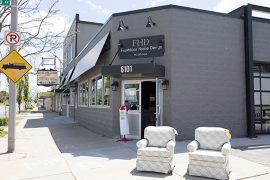An abridged version of this interview was published in the 11th volume of PATTERN Magazine.
Some might think the contemporary art curators to watch are all in New York or Los Angeles. But they’d be wrong. Take Laura Mott in the Detroit area, for example. Curator of contemporary art and design at Cranbrook Art Museum, Mott has authored projects over the past three years that rival anything happening on the coasts. Just a half-hour drive from the heart of the Motor City, up Woodward Avenue, the urban ruin and renewal drama plays out neighborhood by neighborhood. Detroit remains a complicated yet amazing city, which is exactly what drew Mott to the museum. Currently at Cranbrook Art Museum you can see artists: Keith Haring, Ryan McGinness, BASQUIAT and Maya Stovall. But before going, this piece gives form to one of the people who put together exhibits like these.
Shauta Marsh: What does a curator do? It’s not always a job easily understood.
Laura Mott: My iTunes gives me a “curated” playlist, for instance, and I think it’s important to understand art curation isn’t just choosing things. It’s not simply a selection process, but rather a research process. You take on the responsibility of researching, processing, and contextualizing contemporary art and then translating that into an exhibition format. There’s a lot of dialogue with artists, engaging in history and politics, and investigating various other kinds of creative thinking, like literature and philosophy. You are also writer that’s tasked with contributing to what will become art history in the future.
You have to think about how artwork is relevant to us as citizens of the world and also on an immediate, local level. What’s specific to a city like Detroit? What are the artists here making and thinking about right now? How is it relevant to contemporary life on a grander scale?
SM: Academic institution vs. museum institution vs. commercial galleries
LM: I’ve worked in almost every facet of the contemporary art world, including museums, small non-profits, a commercial gallery, an artist residency and taught at universities. They all have advantages and disadvantages. When you work in smaller institutions you typically have more freedom and with larger institutions you have more money and more support.
I started my young adult life as an artist, I didn’t know I’d really enjoy teaching until I started working at an art academy in Sweden. It helped me grow as a thinker because you spend most of your days talking about art, context, and questions like “why is this art?”. Spending a lot of time with artists in their studios has directed my practice as a curator.
SM: There is a strong focus on identity and place with the artists you work with and projects you choose and put together. Is that something you are knowingly aware of with your work and focus?
LM: How an exhibition comes to be is usually years in the making. Our large-scale Nick Cave project in 2015 is a good example. His work was in a group show at Gothenburg Konstallen in 2011, where I was working as a curator and I spent 4 months seeing how people were responding to his work. Gothenberg, Sweden, has a sizeable population of immigrants because the country grants asylum to people who are seeking refuge from tumultuous political situations. It didn’t matter what age, race, or gender, people were gravitating towards Nick’s work. So I was able to observe this over time and it added to the appreciation and fascination with him as an artist.
Then it happened a couple of years later I became the curator at Cranbrook and he is an alumni of Cranbrook Academy of Art. There are divisive boundaries based on race and economy in our immediate region, and it was important to me to activate and expand our programming into Detroit. Nick was a really wonderful artist to work with because he mobilizes people to see performance and gather en masse—it allowed residents to discover parts of their own city they had never visited. To get thousands of people together for an art performance in downtown Detroit is a pretty incredible thing. This may happen for sports or popular music, but for contemporary art that’s an extraordinary moment. We did a massive exhibition complemented by public performances over seven months—ranging from small to extra-large—that resulted in these ecstatic experiences of people forming collective memories together as a city.
Even though I am mindful of overarching ideas like identity, I don’t start projects from such a general topic. It all begins with the art I see in studios, exhibitions, lectures, and publications. Through the constant act of looking, connections are made and an idea will start to germinate. Then the research process begins. Sometimes this takes form as a single artist project, other times as a large, thematic exhibition with multiple artists that is my own creative endeavor.
Place is extremely important, especially since I work at an artistically-significant institution like Cranbrook and within historically-rich Detroit. Ultimately what lands on the exhibition schedule are projects that we feel are important to our community.
SM: When you’re putting together shows, how important is audience for you as a curator?
LM: Each time you work with an artist, it’s a completely different dynamic and new relationship. It’s important you come from a place of shared interest and trust, so everyone is working toward the same purpose. Part of your job as a curator is to communicate the ideas of an artist to the audience, and there are thousands of decisions and strategies that are made between the first meeting to the exhibition closing that go into this activation. Honestly, I think about audience all the time. It’s always a speculative exercise, right? You have this idea of who your audience like a mind map—what are they thinking? how they are going to move in the space? why is this important to them? We deal with multiple audiences at once, ranging from young children to notable academics of the contemporary art and design world. Since Cranbrook Art Museum is attached to a graduate academy in art, architecture, and design, it gives me a little bit more of a direction in deciding on exhibitions since their entire purpose is to be a place of rigorous thought and experimentation. Our collection is really utilized by our education department for school age children, including school-age children from Detroit, Pontiac, and Flint. Last year, for instance, we serviced every 7th grader in Detroit Public Schools.
SM: What is the relationship/responsibility between Cranbrook and Detroit?
LM: When I came to be the curator at Cranbrook, it was equal parts wanting to be work at such a venerable institution like Cranbrook and wanting to work with Detroit. There has always been tension, especially starting in the later part of the 20th century, between Detroit and the suburbs. That’s a real thing. However, I realized when I first started to investigate the art scene, a good number of important Detroit artists had studied at Cranbrook and the academy has contributed to the community for decades. Programmatically, we’ve been proactively and consistently staging projects and events in Detroit for the last few years, like Nick Cave and The Truth Booth. I also did a salon series call the Detroit Bluestockings Crew that led feminist discussions in different locations. My next big project is research-intensive connecting Detroit artists with four other global art scenes post-economic collapse.
 Photo: Laura Mott by Nicola Kuperus
Photo: Laura Mott by Nicola Kuperus




